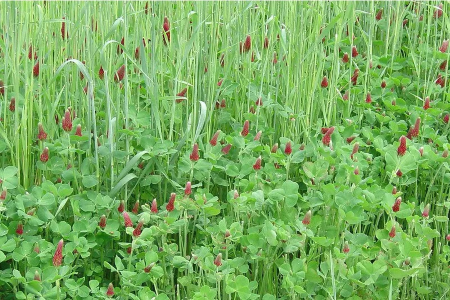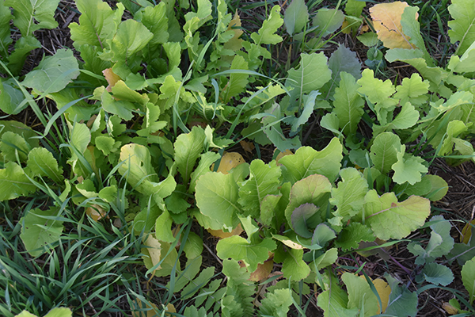Cover Crops in the Vegetable Garden

Soil structure, fertility, and covering the soil are some often overlooked aspects of the vegetable garden that can play a significant role in the success of your gardening season. Why should we care about the soil structure and soil cover? Why is it important? Soil structure impacts how well the plants grow as it affects how water moves into or through the soil and how much oxygen is available for your vegetables. If the soil is uncovered, weeds will likely take advantage of that open ground to grow. We can improve the soil in your vegetable garden by utilizing cover crops through late summer and into the fall or winter.
So why should we spend the time and energy to plant another crop in your garden? Cover crops grown in fall are inexpensive to build better soil for your spring garden and improve soil fertility. Cover crops serve as a living mulch, covering the soil and preventing weeds from germinating in the garden. They consist of grains, grasses, brassicas, or legumes that will grow during fall and winter and that you can mow, spade, or till under in the spring. Cover crops help reduce soil compaction, capture excess nutrients, and prevent erosion during their growth. Their roots penetrate and help loosen heavy-textured soils, allowing better air and water penetration. Legume cover crops add nitrogen to the soil. When you turn cover crops under, they add organic matter, building better soil structure and fertility, or you can cut them off and use them as mulch to keep the soil covered for the growing season. Three different types of cover crop plants can be planted. The first is the legume or pea family. These plants help to fix nitrogen in conjunction with some soil-borne bacteria through nodules in the legume's roots. When these roots break down, the nitrogen is released into the soil for plants to use in the next growing season. Some examples of this family include clovers, field peas, hairy vetch, and sun hemp. The second group consists of the non-legume broadleaves. These groups are the most diverse and are used to help add nutrients to the soil or, in the case of radish, to improve soil structure. Some examples of these plants include radishes, turnips, kale, mustards, and canola. Keep these from going to seed to prevent them from becoming a weedy mess. The final group of cover crops is the grass group. These cover crops are the best for building organic material and cover for the soil because of their abundant root system and the amount of leaf growth above the ground. They include annual or winter rye, wheat, or oats.
nutrients, and prevent erosion during their growth. Their roots penetrate and help loosen heavy-textured soils, allowing better air and water penetration. Legume cover crops add nitrogen to the soil. When you turn cover crops under, they add organic matter, building better soil structure and fertility, or you can cut them off and use them as mulch to keep the soil covered for the growing season. Three different types of cover crop plants can be planted. The first is the legume or pea family. These plants help to fix nitrogen in conjunction with some soil-borne bacteria through nodules in the legume's roots. When these roots break down, the nitrogen is released into the soil for plants to use in the next growing season. Some examples of this family include clovers, field peas, hairy vetch, and sun hemp. The second group consists of the non-legume broadleaves. These groups are the most diverse and are used to help add nutrients to the soil or, in the case of radish, to improve soil structure. Some examples of these plants include radishes, turnips, kale, mustards, and canola. Keep these from going to seed to prevent them from becoming a weedy mess. The final group of cover crops is the grass group. These cover crops are the best for building organic material and cover for the soil because of their abundant root system and the amount of leaf growth above the ground. They include annual or winter rye, wheat, or oats.
How do you get started? One of the easiest ways to begin with cover crops is to scatter leftover cool-season crop seeds such as radish, kale, and carrots in a section of the garden. If this is your first season, I recommend using plants that will kill winter in our area for the first year. Over time, move to a mix of cover crops that includes legumes, grasses, and other broad leaves, depending on your goals and how much money you want to spend on your garden. Most of our cover crops should be planted by mid-October, but some plants, such as winter rye, wheat, or kale, will continue to grow till the soil freezes in the fall. Ultimately, what species you use will depend on your goals. If you have compacted soil, consider using turnips or radishes to help improve the soil structure; if you have weed issues, consider using winter rye to suppress weeds. Cover crops are valuable in the toolbox to help improve your soil. Depending on your needs, you can make your mix as simple or complicated as you want. I will say the more diverse the mix, usually the better. For more information, check out this publication: https://www.extension.purdue.edu/extmedia/HO/HO-324-W.pdf

Have questions? Contact our office where our Horticulture Extension Agent will assist you with questions.
Phone: (316) 321-9660
Email: callae@ksu.edu